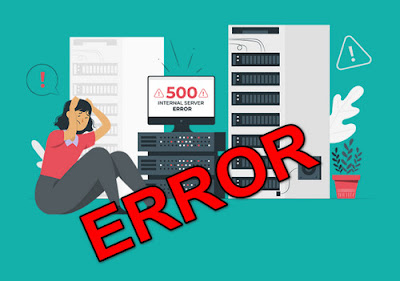Internal Server Error, How to Fix It and Its Causes
You may have experienced when you want to visit a website, but what appears on your browser screen is not the website page you want, but an error message that says "Internal Server Error". What exactly happened? What causes the error message to appear? And how to deal with it?. In this article, we will explain the meaning, causes, and how to overcome Internal Server Error.
What is Internal Server Error?
Internal Server Error is one of the problems often experienced by website managers. This problem is characterized by the appearance of error messages such as "500 Internal Server Error", "HTTP 500 Internal Error", "Internal Server Error", or a blank white screen when accessing the website. Internal Server Error means that something is wrong on the server side that makes the server unable to respond to requests from browsers or clients.
Causes of Internal Server Error
Internal Server Error can be caused by various factors, both from the user, developer, and hosting provider side. Some common causes that often occur are:
Conflict of plugins used.
Plugins are additional programs used to add features or functions to a website. However, sometimes plugins can cause conflicts with other plugins, themes, or website code. This conflict can disrupt website performance and cause errors.
There is an error in the function of the theme used
Theme is the look or design of the website. Themes can also contain certain code or functionality related to the website. If there is an error in the code or function of the theme, the website can experience an error.
Corrupting of . htaccess
An .htaccess file is a configuration file used to regulate server behavior towards websites. This file can manage things like redirect, rewrite, cache, and others. If the .htaccess file is corrupted, incorrect, or inappropriate, the server could get an error.
PHP Memory Limit Issues
PHP Memory Limit is the maximum memory limit that can be used by PHP scripts on a website. If a website uses more memory than the specified limit, the website may experience errors. This can happen because the website contains too many scripts, images, or heavy content.
Incompatible version of PHP, WordPress, or other application
The version of PHP, WordPress, or other applications used on the website must match the version supported by the server. Otherwise, the website may experience errors. This can happen because of differences in features, functions, or security between different versions.
Virus, spoofing, or Trojan attacks
Viruses, spoofing, or trojans are malicious programs that can damage, steal, or alter data on websites. This program can enter websites through security holes, uploaded files, or clicked links. If the website is infected, the website can experience errors.
How to Resolve Internal Server Error
To overcome the Internal Server Error, there are several steps that can be done, including:
Clear Browser Cache
Browser cache is data stored by the browser to speed up the process of loading websites. However, browser caches can sometimes store incorrect or old data that can cause errors. To clear the browser cache, you can use the Ctrl + F5 key combination or follow the guidelines according to the browser used.
Disable problematic plugins
If the website uses plugins, try disabling one by one the plugins used and check whether the website still has errors. If the error goes away after disabling a specific plugin, that plugin caused the error. These plugins can be removed, replaced, or updated as needed.
Repair . corrupted htaccess
If the website uses an .htaccess file, try renaming the file to another name, such as htaccess.txt, and check if the website still has errors. If the error disappears, the .htaccess file caused the error. The .htaccess file can be recreated, repaired, or customized according to the server configuration.
Increase PHP Memory Limit
If the website uses more memory than the specified limit, try increasing the PHP Memory Limit by editing the php.ini, wp-config.php, or .htaccess file. You can follow the guidelines according to the hosting provider used. If you can't edit the file, you can contact the hosting provider for help.
Update your version of PHP, WordPress, or another application.
If the website uses a version of PHP, WordPress, or other applications that are not compatible with the server, try updating that version by downloading the latest version or following the guidelines according to the application used. If you can't update that version, you can contact your hosting provider for help.
Clean viruses, spoofing, or trojans.
If your website is infected by malware, try cleaning it using an antivirus, firewall, or other security application. You can follow the guidelines according to the application used. If you can't clean the website, you can contact the hosting provider for help.
Thus the article about the causes of Internal Server Error and how to overcome it. Hopefully this article is useful and can help you overcome the problems you are experiencing. If you still have difficulties or have questions, please contact us through our support service.

Post a Comment for "Internal Server Error, How to Fix It and Its Causes"
Provide comments relevant to the posted articles and provide critiques and suggestions for the progress of the blog